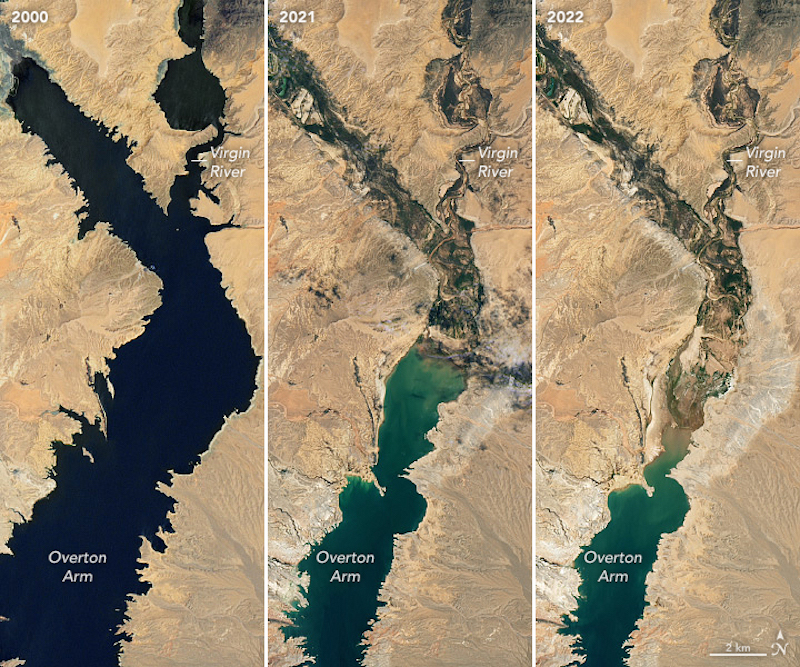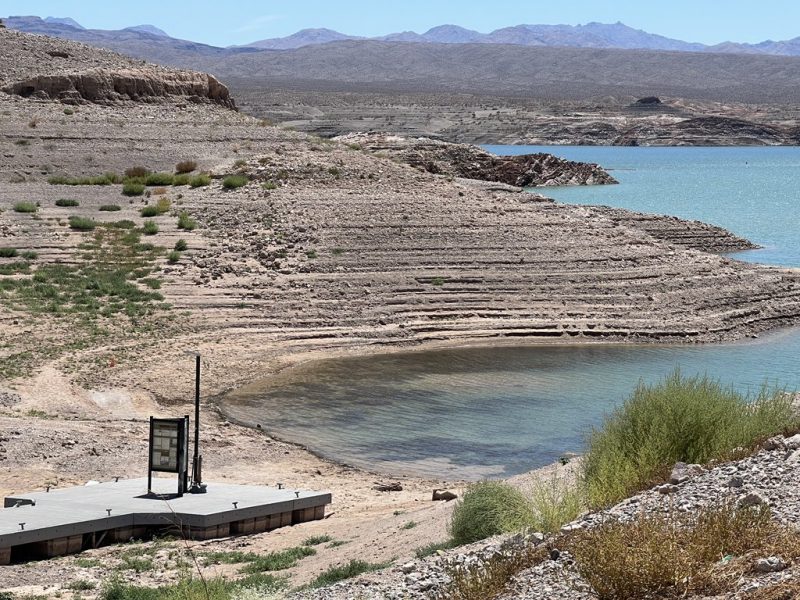
Lake Mead is shrinking
Despite last week’s monsoon rains and flooding in Las Vegas, water levels in Lake Mead – 30 miles (about 50 km) to the east – remain low. They’re at their lowest since the completion of Hoover Dam in the 1930s, which stopped the flow of the Colorado River and created this lake in the desert in the U.S. Southwest.
It was considered a magnificent achievement at the time. But, as of July 31, 2022, Lake Mead’s water level has dropped to 1,040.92 feet (317.3 meters), continuing a 22-year downward trend.
The retreating lake is revealing things hidden underwater for decades. People are finding lots of trash, and also boats, including a World War II-era craft … and human bodies.
What’s more, Lake Mead, on the Colorado River at the Nevada-Arizona border, is the largest reservoir in the U.S. The reservoir supplies water to roughly 25 million people across seven states, tribal lands and northern Mexico.
Lake Mead has been undergoing a downward trend for a couple of decades. But its water levels have fallen precipitously over the last two years. Two years ago, the lake was at 1,084.65 feet (330.6 meters). One year ago, it was at 1,067.71 feet (325.4 meters). By July 31 of this year, at 1,040.92 feet (317.3 meters), the reservoir is at just 27% of capacity.
Patricia Aaron, a spokesperson for the Bureau of Reclamation, told NBC News:
This is the lowest that the reservoir has been since it filled in 1937.
Low water reveals bodies
People have been dumping stuff into Lake Mead for years, and with the dropping waters, some of those secrets are coming to the surface.
On May 1, 2022, a boater noticed a barrel stuck in the mud and made the grisly discovery of a body inside. Las Vegas police believe he was a murder victim who died from a gunshot wound. His killers may have dumped him in the lake in the late 1970s or early 1980s.
Six days later, two sisters paddleboarding in the lake discovered another set of skeletal remains. Lt. Ray Spencer with the Las Vegas police told Las Vegas 8NewsNow:
I would say there is a very good chance as the water level drops that we are going to find additional human remains.
Turns out, he was right. On July 25, the National Parks Service reported that a bystander alerted park rangers to yet another set of human remains at Swim Beach in Lake Mead National Recreation Area. The investigation is continuing.
#BREAKING: The body found in a barrel at Lake Mead may have been underwater for as long as four decades and more bodies are likely to appear as the lake recedes due to severe drought, Las Vegas Metro police tell the @8NewsNow I-Team. https://t.co/LhYkciIJDO #8NN
— David Charns (@davidcharns) May 2, 2022
JUST IN: Another set of human remains was found at Lake Mead as the reservoir's water levels continue to recede, according to a news release from the National Park Service #LakeMead pic.twitter.com/k4MRdTAXLZ
— BNN Newsroom (@BNNBreaking) July 27, 2022
Boats and trash among other discoveries
The receding waters also have exposed dozens of previously sunken boats, including a World War II-era landing craft. According to a July 11 statement to CNN from the National Parks Service (NPS):
The NPS suspects that this WWII surplus craft was put into service on the lake for various reasons and then partially salvaged before it sank in its current location. Whether it sank by accident or was purposely sunk to get rid of a vessel no longer of use is unclear.
The shrinking lake has also revealed many more ordinary human artifacts, such as beer cans, sunglasses, baby strollers, tackle boxes – even handguns and ancient arrowheads – as well as untold amounts of scattered trash.

Why is Lake Mead drying up?
Scientists say the current status of Lake Mead is a stark illustration of climate change and a megadrought that could be the worst in the U.S. West in 1,200 years. A July 22, 2022, NASA statement said:
The low water level comes at time when 74% of nine western states face some level of drought; 35% of the area is in extreme or exceptional drought. In Colorado, location of the headwaters of the Colorado River, 83% of the state is now in drought, and the snowpack from last winter was below average in many places.
Will Lake Mead reach dead pool?
Lake Mead’s water level has dropped more than 170 feet (52 meters) since 1983, the year the Colorado River flooded Hoover Dam’s spillways. If the reservoir dips below 895 feet (272.8 meters) – about 150 feet (45 meters) lower than where it is now – Lake Mead would reach what’s called dead-pool level. Dead pool is when water in a reservoir drops so low that it can’t flow downstream from the dam. If Lake Mead were to reach dead pool – a possibility that scientists say is several years away – there would be dire consequences for the millions of people who rely on the reservoir for drinking water and irrigation.
Minimum power pool elevation
Some media outlets refer to dead pool as the point at which a dam no longer has enough water to generate hydroelectricity. The more accurate term for that, according to University of Arizona professor Robert Glennon, is minimum power pool elevation. That’s when a reservoir is so depleted that there’s not enough water flowing through a dam’s turbines to make them spin, which means the turbines can’t produce electricity. Glennon explained:
When the level in a reservoir approaches minimum power pool elevation, the turbines lose capacity to produce power as they start to take in air along with water and must be shut down before they are damaged. A reservoir that reaches this point usually has quite a bit of water left before it drops to dead pool and water stops flowing from the dam.
According to the U.S. Bureau of Reclamation, the minimum power pool elevation for Lake Mead in order for Hoover Dam to generate power is 950 feet (289 meters) of water. Reminder: As of July 31, 2022, Lake Mead’s water level have dropped to 1,040.92 feet (317.3 meters), continuing a 22-year downward trend.
Dead pool wouldn’t mean that there was no water left in the reservoir. But, even before Lake Mead hits that point, water levels could fall so low that Hoover Dam would have trouble producing hydroelectric power.
What is being done?
According to an NBC News report, the U.S. Bureau of Reclamation and water managers across the southwestern United States have a plan in action. They are making efforts to manage the flow of water into the Colorado River and regulate water use among states in the region.
Since January 2022, states that rely on water from the lower Colorado River have been subject to the cuts that accompany a Tier 1 shortage. On July 18, 2022, CNN reported that more extreme water cuts are all but certain in the U.S. southwest starting next year, according to the latest government forecast for the Colorado River and Lake Mead.
This past Friday (July 29, 2022), the House passed sweeping legislation to provide $500 million to raise plunging water levels in Lake Mead and Lake Powell.

Find the most recent projections about Lake Mead water levels from the Bureau of Reclamation at Colorado River System Projections Overview.
Bottom line: At the end of July 2022, water levels in Lake Mead are at their lowest since the building of Hoover Dam in the 1930s, continuing a 22-year downward trend. The shrinking lake is revealing things hidden underwater for decades, including a World War II boat and a body in a barrel.











